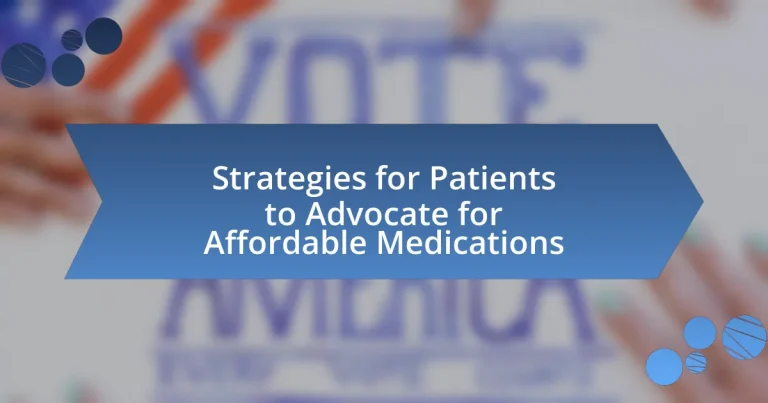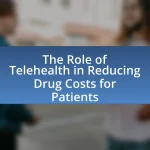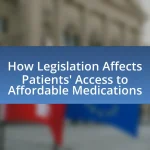The article focuses on strategies for patients to advocate for affordable medications, emphasizing the importance of self-education about medication costs, alternatives, and assistance programs. It outlines effective communication techniques with healthcare providers, the role of patient advocacy groups, and the significance of understanding patient rights in negotiating medication prices. Additionally, it addresses the challenges patients face in accessing affordable medications, including insurance complexities and high drug prices, while providing practical steps for community organizing and leveraging social media for advocacy. The article highlights the necessity of self-care and motivation in sustaining advocacy efforts, ultimately aiming to empower patients in their pursuit of affordable healthcare solutions.
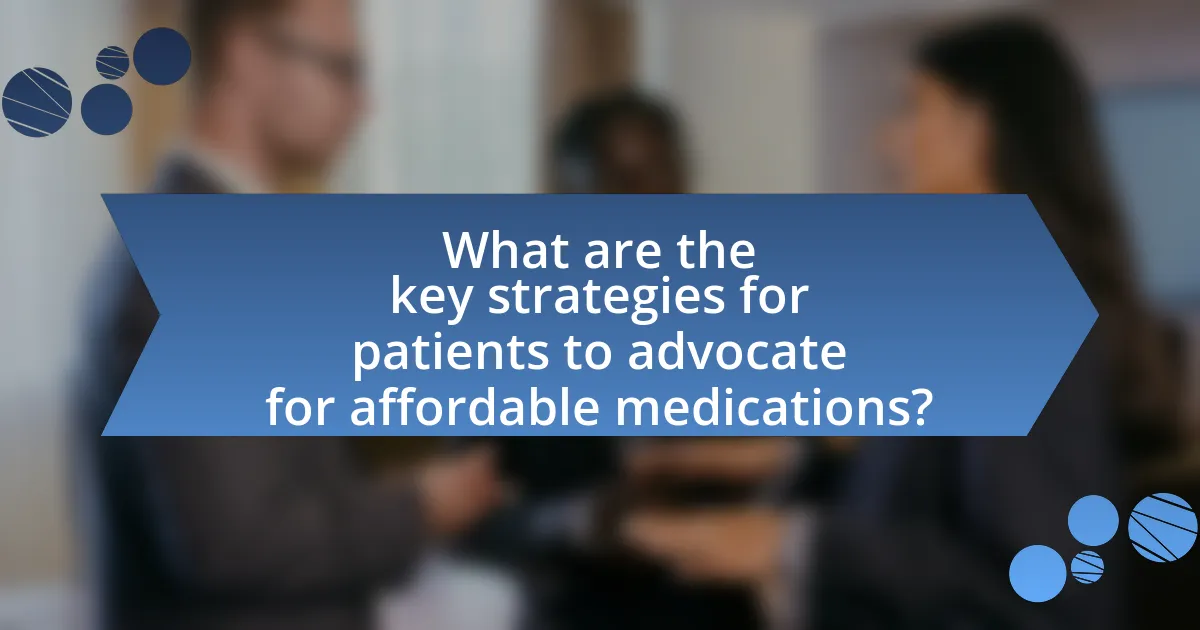
What are the key strategies for patients to advocate for affordable medications?
Patients can advocate for affordable medications by utilizing several key strategies. First, they should educate themselves about their medications, including costs, alternatives, and available assistance programs. This knowledge empowers patients to engage in informed discussions with healthcare providers and pharmacists. Second, patients can join advocacy groups that focus on medication affordability, which can amplify their voices and provide resources for collective action. Third, they should communicate openly with their healthcare providers about financial concerns, as providers may offer lower-cost alternatives or samples. Additionally, patients can leverage social media platforms to raise awareness about high medication costs and share their experiences, thereby influencing public opinion and policy. Lastly, participating in local and national advocacy campaigns can help push for legislative changes aimed at reducing medication prices. These strategies are supported by studies indicating that patient engagement in advocacy can lead to improved access to affordable medications.
How can patients effectively communicate their needs regarding medication costs?
Patients can effectively communicate their needs regarding medication costs by being clear and specific about their financial constraints during consultations with healthcare providers. This involves openly discussing their budget limitations, asking for the cost of prescribed medications, and inquiring about generic alternatives or patient assistance programs. Research indicates that patients who engage in transparent conversations about costs are more likely to receive tailored solutions, such as lower-cost medication options or financial assistance, which can significantly alleviate their financial burden.
What specific information should patients gather before advocating?
Patients should gather detailed information about their medical condition, treatment options, and medication costs before advocating for affordable medications. This includes understanding their diagnosis, the specific medications prescribed, alternative treatments, and the financial implications of these medications, such as insurance coverage and out-of-pocket expenses. Additionally, patients should collect data on patient assistance programs, generic alternatives, and any relevant clinical guidelines that support their treatment choices. This comprehensive knowledge empowers patients to effectively communicate their needs and negotiate for better access to affordable medications.
How can patients articulate their concerns to healthcare providers?
Patients can articulate their concerns to healthcare providers by clearly expressing their symptoms, treatment preferences, and financial limitations. Effective communication involves preparing specific questions and concerns before appointments, using clear and concise language, and actively listening to the provider’s responses. Research indicates that patients who engage in open dialogue are more likely to receive tailored care that addresses their needs, as highlighted in a study published in the Journal of Patient Experience, which emphasizes the importance of patient-provider communication in improving health outcomes.
What role do patient advocacy groups play in this process?
Patient advocacy groups play a crucial role in advocating for affordable medications by representing the interests of patients and influencing policy decisions. These organizations mobilize patients, raise awareness about medication costs, and provide resources to help individuals navigate the healthcare system. For instance, groups like the National Patient Advocate Foundation actively engage in lobbying efforts to promote legislation aimed at reducing drug prices, demonstrating their impact on healthcare policy. Additionally, they often conduct research and publish reports that highlight the financial burdens faced by patients, thereby providing concrete evidence to support their advocacy efforts.
How can patients find and connect with relevant advocacy organizations?
Patients can find and connect with relevant advocacy organizations by utilizing online resources, such as dedicated websites and social media platforms. Many advocacy organizations maintain websites that provide information on their missions, services, and contact details, making it easier for patients to reach out. Additionally, social media platforms like Facebook and Twitter often host groups and pages where patients can engage with advocacy organizations and other individuals facing similar challenges. According to a 2021 survey by the National Health Council, 70% of patients reported using online resources to connect with advocacy groups, highlighting the effectiveness of digital platforms in facilitating these connections.
What resources do these organizations provide to assist patients?
Organizations that advocate for affordable medications provide various resources to assist patients, including financial assistance programs, educational materials, and access to medication discount cards. Financial assistance programs help patients cover the costs of medications through grants or subsidies, while educational materials inform patients about their rights and options regarding medication access. Additionally, medication discount cards can significantly reduce out-of-pocket expenses for prescriptions, making medications more affordable. These resources are designed to empower patients in navigating the complexities of medication costs and access.
Why is it important for patients to understand their rights?
It is important for patients to understand their rights because this knowledge empowers them to make informed decisions about their healthcare and advocate for themselves effectively. Understanding rights enables patients to navigate the healthcare system, ensuring they receive appropriate care, access to medications, and protection against discrimination. For instance, the Patient Protection and Affordable Care Act outlines specific rights related to insurance coverage and access to necessary treatments, reinforcing the necessity for patients to be aware of these provisions to advocate for affordable medications and services.
What legal protections exist for patients regarding medication pricing?
Patients have legal protections regarding medication pricing primarily through laws such as the Affordable Care Act (ACA) and various state-level regulations. The ACA mandates that insurance plans cover essential health benefits, which include prescription medications, thereby limiting out-of-pocket costs for patients. Additionally, some states have enacted laws that require transparency in drug pricing, compelling pharmaceutical companies to disclose pricing information and justifications for price increases. These regulations aim to protect patients from exorbitant medication costs and ensure access to necessary treatments.
How can knowledge of rights empower patients in negotiations?
Knowledge of rights empowers patients in negotiations by providing them with the necessary information to advocate effectively for their healthcare needs. When patients understand their rights, such as the right to informed consent, access to medical records, and the right to appeal insurance decisions, they can confidently engage in discussions with healthcare providers and insurers. This knowledge enables patients to challenge unfair practices, negotiate better terms, and seek alternative options, ultimately leading to more favorable outcomes in their healthcare decisions. For instance, studies show that patients who are informed about their rights are more likely to receive necessary treatments and medications at lower costs, as they can assert their entitlements and navigate the healthcare system more effectively.
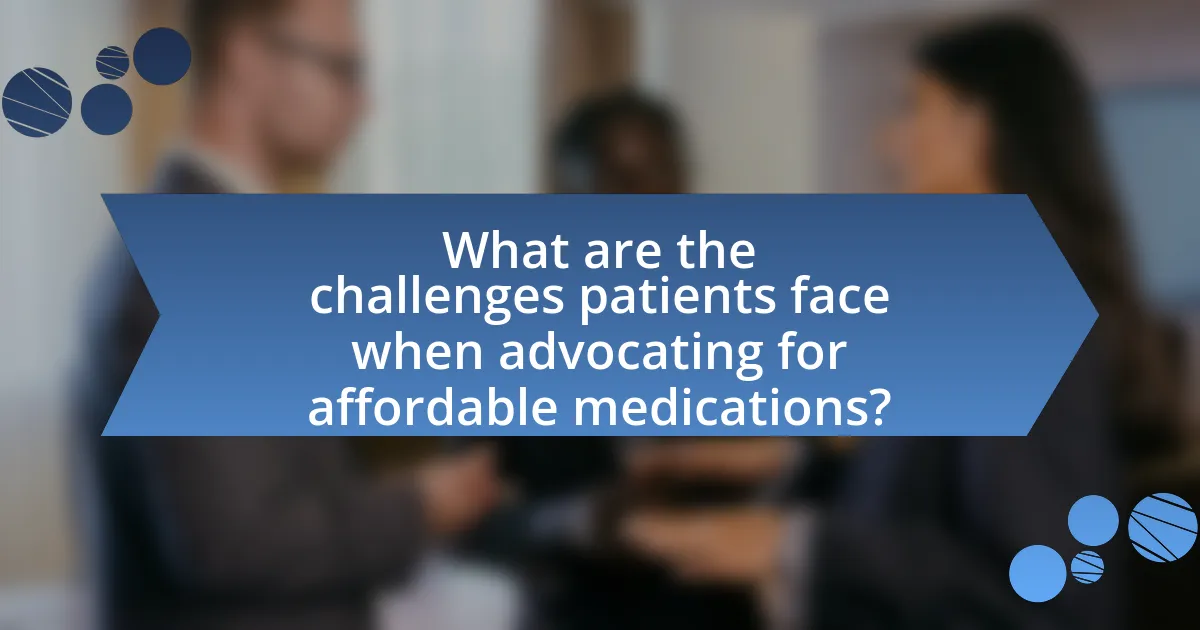
What are the challenges patients face when advocating for affordable medications?
Patients face significant challenges when advocating for affordable medications, primarily due to complex healthcare systems and lack of transparency in drug pricing. The intricate nature of insurance policies often leads to confusion regarding coverage and out-of-pocket costs, making it difficult for patients to understand their options. Additionally, pharmaceutical companies frequently employ pricing strategies that obscure the true cost of medications, further complicating advocacy efforts. A study by the Kaiser Family Foundation found that nearly 1 in 4 Americans reported difficulty affording their medications, highlighting the widespread impact of these challenges. Furthermore, patients may encounter resistance from healthcare providers or insurers when seeking alternatives or negotiating prices, which can discourage them from pursuing advocacy.
What barriers do patients encounter in accessing affordable medications?
Patients encounter several barriers in accessing affordable medications, including high drug prices, lack of insurance coverage, and complex healthcare systems. High drug prices often result from factors such as pharmaceutical company pricing strategies and limited competition in the market. According to a 2021 report by the Kaiser Family Foundation, nearly one in four Americans reported not filling a prescription due to cost. Lack of insurance coverage further exacerbates this issue, as uninsured patients face full retail prices, which can be prohibitively expensive. Additionally, the complexity of healthcare systems, including formulary restrictions and prior authorization requirements, can hinder timely access to necessary medications. These barriers collectively contribute to the challenges patients face in obtaining affordable medications.
How do insurance policies impact medication affordability?
Insurance policies significantly impact medication affordability by determining coverage levels, copayments, and formulary inclusion. These policies dictate which medications are covered, how much patients pay out-of-pocket, and whether certain drugs require prior authorization. For instance, a study published in the Journal of Managed Care & Specialty Pharmacy found that high-deductible health plans often lead to increased out-of-pocket costs for patients, making essential medications less affordable. Additionally, insurance policies that favor generic drugs over brand-name medications can lower costs, as generics typically have lower copayments. Thus, the structure of insurance policies directly influences the financial burden on patients regarding medication access.
What role does the pharmaceutical industry play in medication pricing?
The pharmaceutical industry significantly influences medication pricing through research and development costs, marketing strategies, and patent protections. Pharmaceutical companies invest billions in developing new drugs, which they recoup through high prices, often justified by the need to fund future innovations. For instance, a 2020 study by the IQVIA Institute for Human Data Science reported that the average cost to develop a new drug exceeds $2.6 billion. Additionally, aggressive marketing tactics and lobbying efforts can lead to higher prices, as companies seek to maximize profits. Patent protections allow these companies to maintain monopolies on their products, further enabling them to set prices without competition.
How can patients overcome these challenges?
Patients can overcome challenges in advocating for affordable medications by actively engaging with healthcare providers, utilizing patient assistance programs, and collaborating with advocacy organizations. Engaging with healthcare providers allows patients to discuss medication costs and explore alternatives, which can lead to more affordable options. Utilizing patient assistance programs, offered by pharmaceutical companies and non-profits, can provide financial support or access to medications at reduced costs. Collaborating with advocacy organizations, such as the National Patient Advocate Foundation, can empower patients through resources, education, and collective action, enhancing their ability to influence policy changes that promote medication affordability.
What strategies can patients employ to navigate insurance issues?
Patients can navigate insurance issues by thoroughly understanding their insurance policy, including coverage details, co-pays, and deductibles. This knowledge allows patients to identify which medications are covered and the associated costs. Additionally, patients should maintain open communication with their healthcare providers to discuss medication options and potential alternatives that may be more affordable. Utilizing patient assistance programs offered by pharmaceutical companies can also provide financial support for expensive medications. Furthermore, patients can appeal insurance denials by providing necessary documentation and evidence of medical necessity, which can increase the chances of obtaining coverage for needed treatments. These strategies are effective as they empower patients to take control of their healthcare decisions and reduce out-of-pocket expenses.
How can patients leverage social media for advocacy?
Patients can leverage social media for advocacy by sharing personal stories, connecting with others facing similar challenges, and raising awareness about issues related to affordable medications. By utilizing platforms like Twitter, Facebook, and Instagram, patients can amplify their voices, engage with healthcare professionals, and mobilize support for policy changes. Research indicates that social media campaigns can significantly influence public opinion and policy decisions, as seen in movements like #PatientsOverPharma, which successfully highlighted the need for lower drug prices.
What are the potential risks of advocating for affordable medications?
Advocating for affordable medications carries potential risks such as backlash from pharmaceutical companies, which may lead to reduced funding for research and development. This is evidenced by the fact that when advocacy efforts challenge pricing structures, companies may respond by cutting back on innovation, as seen in the 2019 report from the Pharmaceutical Research and Manufacturers of America, which indicated that 56% of companies reduced R&D budgets in response to public pressure. Additionally, advocates may face legal challenges or regulatory scrutiny, as seen in various cases where advocacy groups were targeted for their campaigns against drug pricing. These risks highlight the complexities involved in pushing for affordable medications while navigating the interests of powerful stakeholders in the healthcare industry.
How can patients protect themselves from backlash or negative consequences?
Patients can protect themselves from backlash or negative consequences by documenting their interactions with healthcare providers and maintaining open communication. Keeping detailed records of prescriptions, treatment plans, and conversations can provide evidence if disputes arise. Additionally, patients should seek support from advocacy groups that specialize in medication access, as these organizations can offer guidance and resources to navigate potential challenges. Research indicates that patients who actively engage in their healthcare decisions and seek assistance from advocacy groups report higher satisfaction and fewer negative experiences.
What should patients consider before taking a public stance?
Patients should consider the potential impact of their public stance on their health, privacy, and relationships. Public advocacy can lead to increased visibility, which may affect personal safety and emotional well-being. Additionally, patients must evaluate the support systems available to them, as public advocacy can be isolating without a strong network. Research indicates that patients who engage in advocacy often face backlash or differing opinions, which can strain personal relationships. Therefore, understanding the risks and benefits, as well as having a clear message and support, is crucial for effective public advocacy.
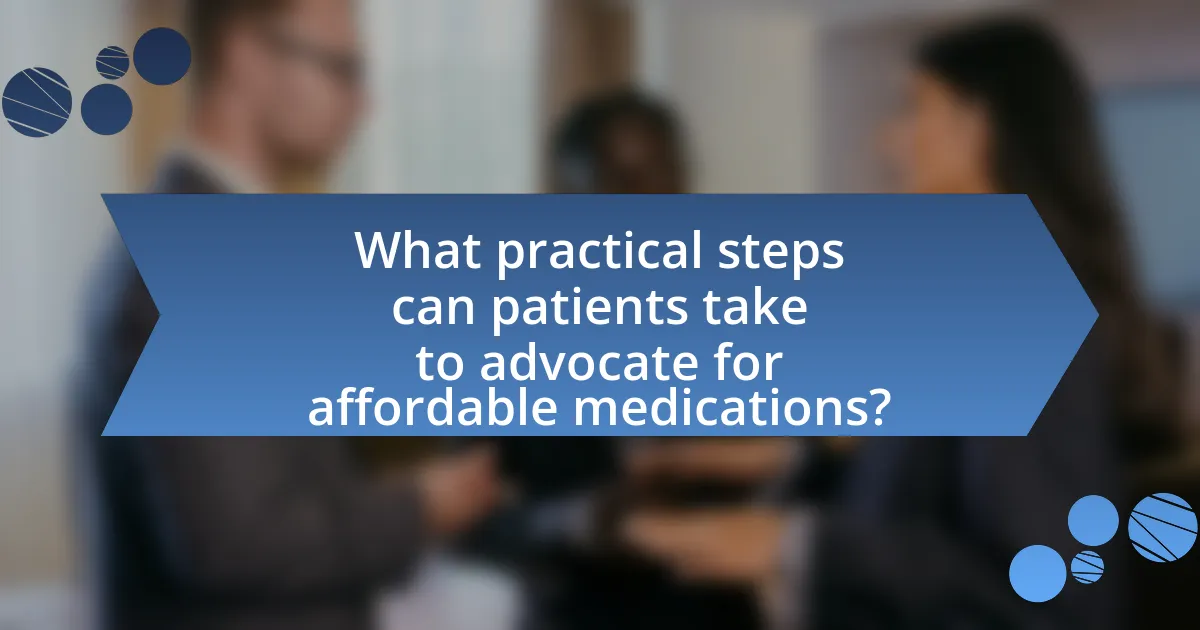
What practical steps can patients take to advocate for affordable medications?
Patients can advocate for affordable medications by actively engaging with healthcare providers, insurance companies, and policymakers. They should start by discussing medication costs with their healthcare providers to explore lower-cost alternatives or generic options. Additionally, patients can contact their insurance companies to understand their coverage options and appeal for coverage of necessary medications if denied. Joining advocacy groups focused on medication affordability can amplify their voices and provide resources for collective action. Furthermore, patients can participate in public forums or contact local representatives to express their concerns about high medication prices, thereby influencing policy changes. According to a report from the Kaiser Family Foundation, nearly 1 in 4 Americans have reported not filling a prescription due to cost, highlighting the need for advocacy in this area.
How can patients effectively organize community efforts for advocacy?
Patients can effectively organize community efforts for advocacy by forming support groups that focus on shared experiences and goals related to affordable medications. These groups can facilitate communication, mobilize resources, and create a unified voice to influence policymakers. Research indicates that collective action, such as petitions and community meetings, can significantly impact legislative changes; for example, the 2019 campaign for the Affordable Drug Pricing Act involved grassroots mobilization that garnered over 100,000 signatures, demonstrating the power of organized advocacy. By leveraging social media platforms, patients can also raise awareness and engage a broader audience, amplifying their message and increasing pressure on decision-makers.
What are the best practices for forming a patient advocacy group?
The best practices for forming a patient advocacy group include identifying a clear mission, engaging stakeholders, and establishing effective communication channels. A clear mission focuses the group’s efforts on specific issues, such as advocating for affordable medications. Engaging stakeholders, including patients, healthcare providers, and policymakers, ensures diverse perspectives and strengthens the group’s influence. Establishing effective communication channels, such as social media and newsletters, facilitates outreach and mobilizes support. These practices are supported by successful advocacy groups that have effectively influenced healthcare policies and improved patient access to medications.
How can patients engage with local lawmakers to influence policy?
Patients can engage with local lawmakers to influence policy by participating in advocacy efforts, such as attending town hall meetings, contacting representatives through calls or emails, and joining local health advocacy groups. These actions allow patients to voice their concerns about medication affordability directly to lawmakers, fostering dialogue and awareness of the issues they face. For instance, a study by the American Medical Association found that direct communication from constituents significantly impacts lawmakers’ decisions on health policy. By sharing personal stories and data on medication costs, patients can effectively highlight the need for legislative changes that promote affordable medications.
What tools and resources are available for patients to aid their advocacy?
Patients can utilize various tools and resources to aid their advocacy for affordable medications, including patient advocacy organizations, online platforms, and educational materials. Patient advocacy organizations, such as the National Patient Advocate Foundation, provide resources, support, and guidance on navigating healthcare systems and policies. Online platforms like PatientsLikeMe allow patients to share experiences and gather information about medication costs and alternatives. Additionally, educational materials, including brochures and webinars from healthcare providers and advocacy groups, equip patients with knowledge about their rights and options, enhancing their ability to advocate effectively.
How can patients utilize online platforms for information and support?
Patients can utilize online platforms for information and support by accessing health-related websites, forums, and social media groups that provide resources and community engagement. These platforms offer a wealth of information, including medication options, pricing comparisons, and patient experiences, which can empower patients to make informed decisions about their healthcare. For instance, websites like PatientsLikeMe and HealthUnlocked allow users to share their experiences and learn from others facing similar health challenges, fostering a sense of community and support. Additionally, social media platforms enable patients to connect with advocacy groups that focus on affordable medications, providing updates on legislative changes and access to resources that can aid in their advocacy efforts.
What are the most effective ways to share personal stories to raise awareness?
The most effective ways to share personal stories to raise awareness include utilizing social media platforms, engaging in community events, and collaborating with advocacy organizations. Social media allows individuals to reach a broad audience quickly; for instance, platforms like Twitter and Instagram have been used to amplify personal narratives, leading to increased engagement and awareness around issues like medication affordability. Community events, such as local health fairs or support groups, provide a personal touch, allowing individuals to connect face-to-face and share their experiences directly, which can foster empathy and understanding. Collaborating with advocacy organizations can also enhance visibility; these organizations often have established networks and resources to help disseminate personal stories widely, thereby increasing their impact. Research indicates that storytelling can significantly influence public perception and policy change, as evidenced by campaigns that have successfully shifted attitudes towards healthcare access and affordability.
What tips can help patients stay motivated in their advocacy efforts?
Patients can stay motivated in their advocacy efforts by setting clear, achievable goals. Establishing specific objectives allows patients to track their progress and celebrate small victories, which reinforces their commitment. Additionally, connecting with support groups or networks provides emotional encouragement and shared experiences, making the advocacy journey less isolating. Research indicates that social support significantly enhances motivation levels, as seen in a study published in the Journal of Health Psychology, which found that individuals with strong social networks are more likely to persist in their advocacy efforts. Engaging in continuous education about the issues at hand also empowers patients, as informed advocates are more effective in their efforts.
How can patients track their progress and celebrate small victories?
Patients can track their progress and celebrate small victories by maintaining a detailed health journal that records symptoms, medication adherence, and emotional well-being. This method allows patients to visualize improvements over time, reinforcing positive behaviors and providing motivation. Research indicates that self-monitoring can enhance patient engagement and adherence to treatment plans, leading to better health outcomes. For instance, a study published in the Journal of Medical Internet Research found that patients who actively tracked their health reported higher satisfaction and perceived progress in their treatment.
What role does self-care play in sustaining advocacy efforts?
Self-care is essential for sustaining advocacy efforts as it helps maintain the physical and mental well-being of advocates, enabling them to engage effectively in their causes. When advocates prioritize self-care, they experience reduced burnout and increased resilience, which are critical for long-term commitment to advocacy work. Research indicates that individuals who practice self-care report higher levels of motivation and effectiveness in their advocacy roles, as they are better equipped to handle the emotional and psychological demands of their efforts. For instance, a study published in the Journal of Health Psychology highlights that self-care practices, such as mindfulness and regular exercise, significantly enhance emotional regulation and stress management, thereby supporting sustained advocacy engagement.
